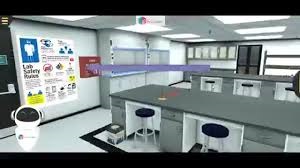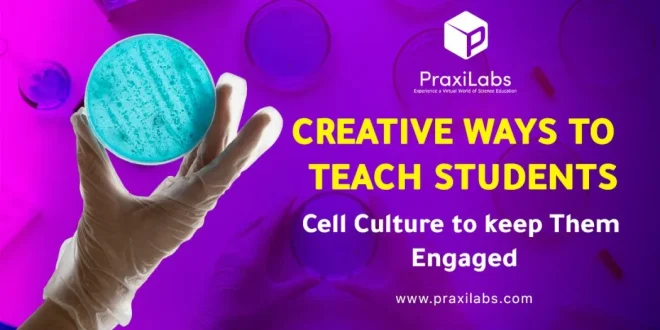Last Updated on August 22, 2025 by Muhamed Elmesery
Are you a teacher or instructor looking for interactive and creative ways to teach your students how to culture cells? culturing cell can be a challenging task for most students, but with the right approach, it can become an exciting and engaging learning experience for them.
Cell culturing is the growth of cells from an animal in an artificial, controlled environment. Cells are removed either from the organism directly and disaggregated before cultivation or from a cell line or cell strain that has previously been established.
In this blog post, we will shed light on 5 creative ways to teach students culturing cells to keep them engaged, as cell culture is a very important protocol for preparing cells needed for all subsequent In Vitro Genotoxicity and Cytotoxicity assays.
Table of Contents
Top 5 Creative Ways to Teach Students Counting Cells to keep Them Engaged
-
Using Interactive Models and Simulations

Using interactive models and simulations plays a vital role in keeping all students engaged and enhancing their learning outcomes, as engaging students with these creative approaches helps students understand the scientific concepts, protocol, and principle of work clearly before starting the cell culture experiment in the real laboratory.
Models and virtual simulations in teaching can also be utilized to build scientific skills in higher education, empowering students to develop essential knowledge and skills in biology, as well as in-demand, transportable skills like critical thinking, problem-solving, communication, creative thinking, and collaboration.
Culturing cells can also be utilized to bridge the gap between lab and lecture courses, as they are used for pre-lab preparation, biology lectures, online lectures, or in conjunction with textbooks.
-
Learning with Games and Activities

A research project by Deakin University found that 75% of students agreed that games could help them to learn, and that all games are appropriate for learning. The research found that in most cases it was not the game itself but the ways that teachers used games to teach complex concepts that made the biggest difference.
According to students who participated in the research, games can:
- Make complex concepts and topics more interesting, attractive and meaningful
- Help students become independent and engaged in the future
- Provide opportunities to solve problems and learn trial and error strategies
- Support a wide range of learners and interests
- Enhance learning that stimulates imagination and deep understanding
- Help students collaborate on a shared goal (support communication skills)
PraxiLabs virtual labs provide an Awesome Game-Like Experience that helps your students practice game-like online experiments with experimental design simulations in science without any limits. With an awesome lab partner Oxi, skipping ahead (recorded in reports), hints, and so much more, attract attention and make your students’ science learning intuitive and personalized.
-
Infusing Technology into Study Plans
The target of integrating technology into study plans is to allow more effective communication between students and instructors. Using technology in your classrooms also gives students a chance to have a voice in their learning. Students are empowered to take responsibility for their learning through participating in projects, giving feedback on lessons, and learning activities that respect their individuality, and having opportunities to understand how to use several technologies creatively, and safely.
There are many examples of technologies that you can apply in your classroom such as:
- Video
- Multimedia lessons
- Presentations
- Creating digital content
- Digital field trips
- Gamified learning
- Digital interactive whiteboards
- Virtual lab simulations
4. Inspiring Learners by Connecting to Career Prospects

Instructors and teachers can connect culture cells to career prospects by highlighting the diverse range of careers available in fields such as biotechnology, molecular biology, pharmaceutical research, tissue engineering, and more. This can provide students with a clear understanding of the potential career paths related to cell culture and encourage them to study hard.
Here are some examples of careers related to cell culture
- Cell Culture Technician
- Bioprocess Engineer
- Regenerative Medicine Researcher
- Cell Culture Specialist
- Tissue Engineer
- Infectious disease specialist
Encouraging students to engage and contact industry professionals through internships, mentorship programs, and events can provide valuable information about the practical applications of cell culture in various career fields to help students make the right decisions about their future career paths.
-
Culturing cell Simulation
Virtual labs that provide cell culture simulations, such as PtaxiLabs’ virtual simulation ” Adherent Cell Culturing Using Mammalian Cell Lines”, are considered interactive and effective ways to teach students culturing cells to keep them engaged.
Studies found that Virtual Labs Improve Students’ Outcomes:
- 60% increase in students’ performance.
- 80% increase in students’ retention.

Cell Culture Basics Virtual Lab Registration from PraxiLabs
Cell culture virtual laboratory simulation from PraxiLabs aims to learn how cells are cultured, subcultured, propagated and frozen in liquid nitrogen for long-term storage.
Cell culture is an amazing tool that allows for easy control and manipulation of all physiochemical and physiological cell factors, such as temperature, osmotic pressure, pH, gas, hormones, media, and supplements.
By the end of the experiment, students can:
- Successfully handle the required instruments and consumables needed in cell culturing and sub-culturing.
- Work and follow the general safety guidelines for Good Laboratory Practice (GLP).
- Strictly work and follow the Aseptic Techniques of cell culturing.
- Thaw cells from Liquid Nitrogen and seed them in cell culture flasks.
- Check the confluence, harvest cells, and count them microscopically.
- Scale-up the cultured cells for the setting of further experiments.
- Freeze cells in Liquid Nitrogen for long-term storage.
In this protocol, adherent cell lines will be first thawed from liquid nitrogen and seeded in a cell culture flask. After 24 hours, cells will be visualized by a light microscope for confluency in order to define the best time for sub-culturing and scaling-up of cells. Once the cells exceed 90% confluency, they will be sub-cultured and passaged into other culture vessels. For long-term storage, cells will be frozen in a special freezing medium before storing them in liquid nitrogen.
Create your free account and try our simulations now!
 PraxiLabs A virtual world of science
PraxiLabs A virtual world of science






